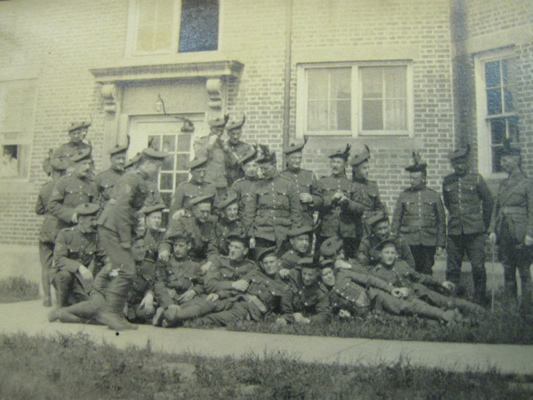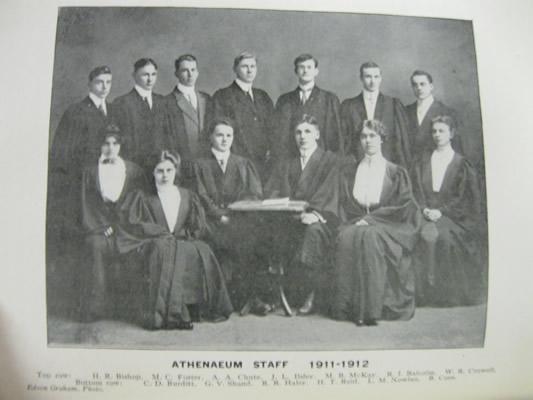World War One

The Effects of War
The Great War brought the growth and development of Acadia to a halt due to the pressures of war and economic depression. Student enrollment was on the decline as young men began to enlist in the war. As a result of decreased students, and the economic strain, female residents and remaining males were now living in Seminary and were forced to pay increased rates and board for rooms. In 1915 the price to live in Seminary for one week was $4.50, and in the spring of 1918 a room cost $5.75. Previous to the war women tended to live a relatively free life on campus but as the war began, women were expected to have written permission if they wanted to leave the campus for any reason.
Academic Life and the War
-"The boys are forming an officers' training corps here. Over 100 are joining, I guess."
-"Volunteers are being solicited for a second Canadian Contingent, and already 450 are mobilized at Halifax. There is a general sentiment around Acadia that a training corps should be established here. However, the Government has not yet made such a request."
-"Prof. Hannay's lecture on the war was fine. The three causes from Germany's standpoint were German unity, the German "macht politik," "might is right," & desire for colonies. He made one feel sorry for Germany. For the sake of making their culture, learning, & social development that of the world, for the German ideal that a strong nation should assert itself & force its doctrines, methods, etc. on a weaker nation, Germany has given up its national honour. He gave it as his firm conviction that England never entered a war with cleaner hand. He said that there would be no victory, nor no defeat, but that right would triumph."
excerpts from Esther Goes to College
The outbreak of World War One brought many opportunities for women at Acadia. In 1906, 4 students out of a class of 20 were women and in 1916 the majority of the graduating class, 19 out of 33 were women. This was also the first class in which the majority did not marry.
Women at Acadia also became substantially more involved in activities on campus. This role is seen through participation on organizations, studentís councils, and staff of the athenaeum.
"The plans of many young men who anticipated coming to the academy were changed owing to the great war. Some of the men as in camp temporarily while others will go to the front with the Canadian contingent, while the attendance will be smaller than it was expected during the breaking out of war it will be fully as large as can be expected under the circumstance."
Acadia Bulletin, vl 3, no 8 sept 1 1914.
While males were overseas the female students of Acadia took on male jobs. Offices and honors which were previously held by male students now transformed. For the first time, in 1917 Helen Starr became the first female editor of the Athenaeum. This new position was a dramatic shift in gender roles on campus because women were previously limited in extra curricular activities. Helen Starr's appointment was a stark contrast to the traditional, pre-War role of women in the Atehnaeum as seen in the image below.
During the First World War, the female students of Acadia were able to gain experiences and insight into the public sphere. Although these were only temporary experiences, they were able to prove to themselves and others that they were fully capable of doing any task a male had previously done. They organized meetings, worked for the newspaper, designed social events and brought home honors. It was a positive shift, but as males returned from the Great War they began to take over the jobs they had left once behind.
Armistice

At 5:30am Monday November 11, the news of the signing of the armistice was received and immediately the college bell rang out the news to the town and hill. At 6 am on that morning the total of the student body of the three institutions met in the college chapel for a thanksgiving prayer service. The students with friends from the town met around the flagpole and later went to assembly hall where addresses were made by professors and students. At 12, the students and town people met in the churches where services were held. At 2:30, a procession was formed near the railway station and paraded through the town. At 8pm, a bonfire for which the students were preparing was started. These events demonstrate the joy which was felt across campus by students and staff. The armistice did provide a sense of relief for female students who had lost contact with male friends and relatives but it also signified the return of males into most prominent academic and social positions on campus.
| |